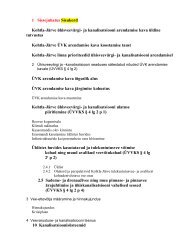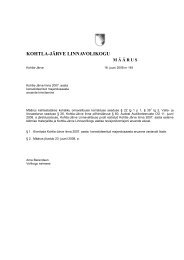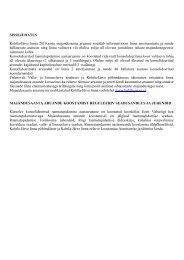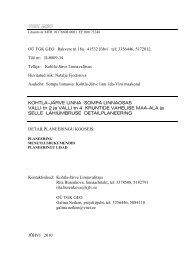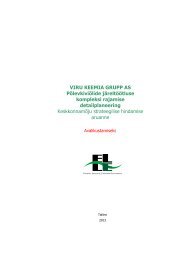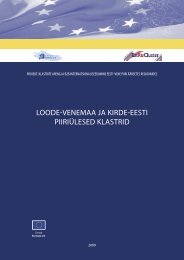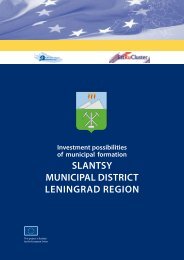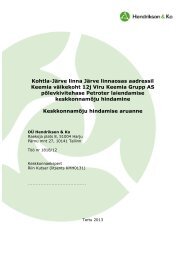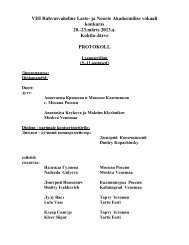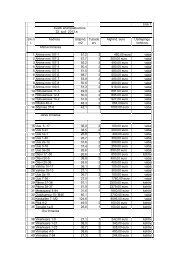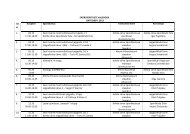FINAL CLUSTER ANALYSIS - Kohtla-Järve
FINAL CLUSTER ANALYSIS - Kohtla-Järve
FINAL CLUSTER ANALYSIS - Kohtla-Järve
Create successful ePaper yourself
Turn your PDF publications into a flip-book with our unique Google optimized e-Paper software.
5.1. KeY FInDIngs In IDa-vIrumaa<br />
5<br />
The current Estonian policy is mainly based on horizontal<br />
measures, related to entrepreneurship, export promotion,<br />
innovation and R&D support, foreign direct investments<br />
and access to capital. Future development of state measures<br />
partly is planned to be realised through the cluster approach,<br />
as previously revealed by the Estonian R&D Strategy<br />
“Knowledge-based Estonia” (2002-2006). One of the<br />
instruments that can apply here is the creation of so-called<br />
Competence Centres. Sectoral studies have been conducted,<br />
which have shown that the ties between the enterprises<br />
within the clusters, as well as the enterprises’ ties with<br />
research institutions, are weak, using the argument that Estonia’s<br />
case concerns operation within international (North<br />
European) rather than domestic clusters and therefore the<br />
policy of supporting the clusters cannot be efficient. Most<br />
of the EU studies consider Estonia quite undeveloped in<br />
terms of clustering activities. The emergence and development<br />
of clusters that would create competitive advantages<br />
has been restrained by the lack of a critical mass of strong<br />
enterprises acting in one sector, which amplified the need<br />
for Estonian enterprises to find and develop cooperation<br />
with enterprises outside Estonia.<br />
During this structural assistance period, 2007-2013 entrepreneurship<br />
is among supported fields. Key goal is to introduce<br />
the cluster-based approach in less knowledge and<br />
technology-intense sectors and traditional branches of<br />
the economy. For raising the innovation capacity in traditional<br />
economic sectors and building critical mass through<br />
enterprise cooperation (incl. with R&D institutions), it will<br />
be important to implement cluster specific approach. The<br />
development of cooperation networks joining enterprises,<br />
R&D institutions and local municipalities will be supported.<br />
In the clusters that have been activated by the “bottom<br />
up” approach, inter-enterprise cooperation in the fields of<br />
training, product development and export marketing will<br />
be supported.<br />
Support measures to the cluster-specific needs will be ensured,<br />
such as cooperation between enterprises in the foreign<br />
market participation will be supported sharing of orders,<br />
formation of export consortiums and joint marketing.<br />
Documentary<br />
Survey results<br />
Final Cluster Analysis<br />
Estonia has now several good opportunities to improve its<br />
innovation capacity:<br />
The development of a new R&D Strategy for 2007 -2013<br />
and the new round of Structural Funds;<br />
The ongoing development and launching of new innovation<br />
support schemes targeting the existing company<br />
base and its needs to become more competitive;<br />
The launching of a State venture capital fund in 2005<br />
and the increased financial support for national R&D<br />
infrastructures.<br />
The development of Estonian innovation policy is mainly<br />
obstructed by two factors: Insufficient awareness of the<br />
need for an innovation policy among politicians, different<br />
understanding of innovation policy among various ministries<br />
and the lack of resources.<br />
In 2008 Estonia Ministry of Economics & Communication<br />
as a responsible body for implementation Operational Programme<br />
for Development of Economic Environment proposed<br />
that grants for development of innovative clusters<br />
under Capability of innovation and growth of business priority<br />
would be made available in October 2008, as Regulation<br />
of the measure will enter into force. Total amount of<br />
100 million EEK (6,3 million EUR) for 2008-2013 will be allocated<br />
towards cluster initiatives in Estonia.<br />
Documentary survey revealed that the largest economic<br />
spheres in Ida-Virumaa regions are: shale oil refining, electricity<br />
and heating power production, chemical industry,<br />
trade, construction and building of materials, woodworking,<br />
metalworking, food processing, tourism. The backbone<br />
of Ida-Virumaa industry is formed with oil shale production<br />
and power engineering complex, internationally competitive<br />
production, as well as development service sectors: logistics<br />
and tourism. The most essential strategic priorities for<br />
economic development in North-East Estonia according to<br />
Ida-Virumaa County Development Plan (2005-2013) are:<br />
Power production, • Power production – in addition to<br />
generating power based on local raw material - oil-shale,<br />
it is also one of the most rapidly developing regions in<br />
Estonia using wind energy for power production;<br />
21



